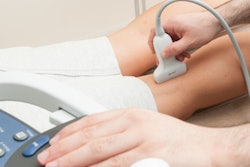
CT angiography (CTA) is an effective way to evaluate the risk of pulmonary embolism (PE) in patients with COVID-19, especially those who are obese or who have high levels of inflammation when they present at the hospital, according to a study published May 14 in Radiology.
The findings could help clinicians better care for COVID-19 patients at risk of the condition, wrote a team led by Dr. Neo Poyiadi of the Henry Ford Health System in Detroit.
"In our study, patients with a body mass index of more than 30 kg/m2 were 2.7 times more likely to develop a PE," the group wrote.
Thrombotic complications like pulmonary embolism, deep vein thrombosis, ischemic stroke, and myocardial infarction are manifesting in COVID-19 patients with increasing frequency, the researchers noted. So what makes some patients more vulnerable to these complications compared with others? Poyiadi and colleagues sought to address the question by evaluating the clinical characteristics of patients with COVID-19 who developed pulmonary embolism compared with those who did not.
The study included chest CT exams performed between March 16 and April 18. Poyiadi's group identified 328 patients with positive reverse transcription polymerase chain reaction (RT-PCR) results who had undergone pulmonary CTA. The researchers assessed patient reports for the presence of pulmonary embolism and variables such as hypertension, history of pulmonary embolism, a body mass index greater than 30, statin therapy, and D-dimer values.
Of the total patient cohort, 22% had pulmonary embolism, according to the team. It also found that heavier patients, those with higher mean C-reactive protein and mean D-dimer values, and those (nonintubated) patients who required more oxygen before the CTA exam tended to develop pulmonary embolism.
| Risk factors for developing pulmonary embolism in patients with COVID-19 | |||
| Variable | No pulmonary embolism | Pulmonary embolism | P-value |
| BMI > 30 | 44% | 58% | 0.05 |
| C-reactive protein mg/dl | 7.4 | 10 | 0.01 |
| D-dimer mg/ml | 2.54 | 9.33 | 0.001 |
| Oxygen requirements average L/min (before CTA performed) | 2.7 | 4.3 | 0.007 |
Surprisingly, the team found no statistically significant difference in patients who developed PE compared with those who did not when it came to intensive care unit (ICU) admissions, the need for intubation, or the duration of intubation.
"In fact, 72% of pulmonary embolisms were diagnosed in patients who did not require ICU-level care," the team wrote. "This is in sharp contrast to a recently published study highlighting PE to be associated with ICU admission and mechanical ventilation. Our results suggest that even patients who do not have severe enough illness to qualify for ICU care can develop acute pulmonary embolism."
Poyiadi and colleagues hope their research will help clinicians effectively assess PE risk in patients with COVID-19.
"Our study, in conjunction with recent and future studies, may prompt early evaluation with pulmonary CT angiography in COVID-19 patients who are at increased risk for developing pulmonary embolism based on demographic, clinical, and laboratory variables," the group wrote.





















